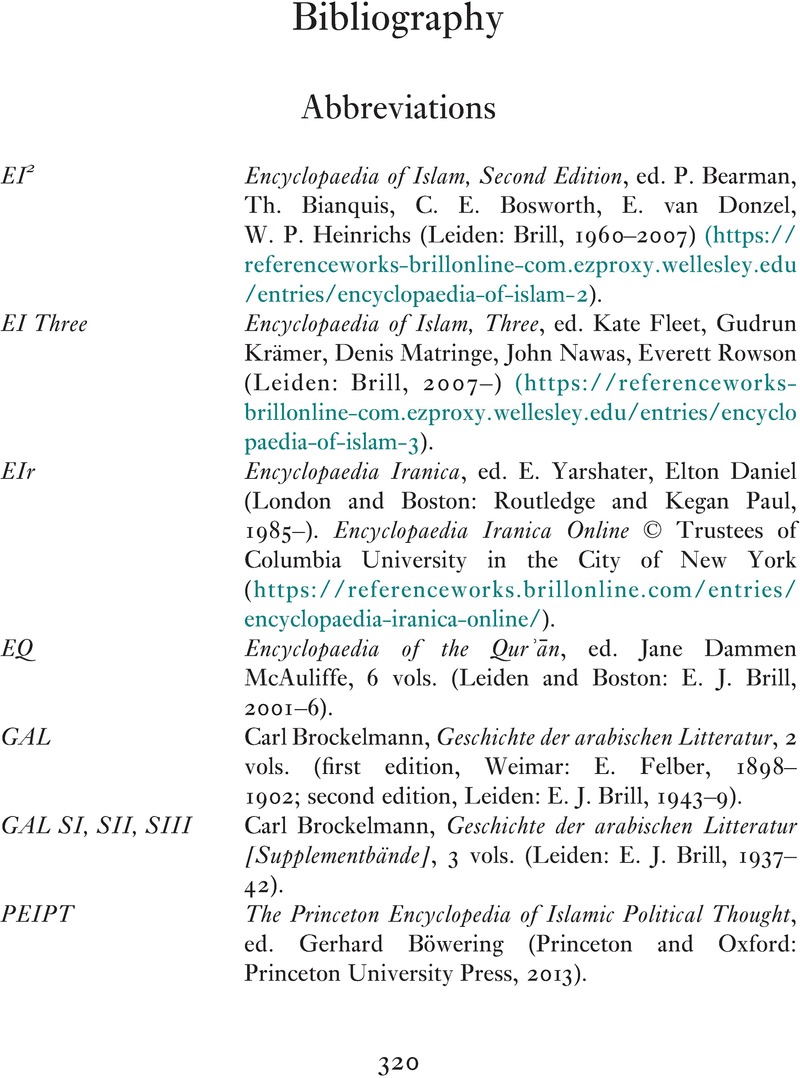Published online by Cambridge University Press: 15 January 2023

Encyclopaedia of Islam, Second Edition, ed. P. Bearman, Th. Bianquis, C. E. Bosworth, E. van Donzel, W. P. Heinrichs (Leiden: Brill, 1960–2007) (https://referenceworks-brillonline-com.ezproxy.wellesley.edu/entries/encyclopaedia-of-islam-2).
Encyclopaedia of Islam, Three, ed. Kate Fleet, Gudrun Krämer, Denis Matringe, John Nawas, Everett Rowson (Leiden: Brill, 2007–) (https://referenceworks-brillonline-com.ezproxy.wellesley.edu/entries/encyclopaedia-of-islam-3).
Encyclopaedia Iranica, ed. E. Yarshater, Elton Daniel (London and Boston: Routledge and Kegan Paul, 1985–). Encyclopaedia Iranica Online © Trustees of Columbia University in the City of New York (https://referenceworks.brillonline.com/entries/encyclopaedia-iranica-online/).
Encyclopaedia of the Qurʾān, ed. Jane Dammen McAuliffe, 6 vols. (Leiden and Boston: E. J. Brill, 2001–6).
Carl Brockelmann, Geschichte der arabischen Litteratur, 2 vols. (first edition, Weimar: E. Felber, 1898–1902; second edition, Leiden: E. J. Brill, 1943–9).
Carl Brockelmann, Geschichte der arabischen Litteratur [Supplementbände], 3 vols. (Leiden: E. J. Brill, 1937–42).
The Princeton Encyclopedia of Islamic Political Thought, ed. Gerhard Böwering (Princeton and Oxford: Princeton University Press, 2013).
To save this book to your Kindle, first ensure [email protected] is added to your Approved Personal Document E-mail List under your Personal Document Settings on the Manage Your Content and Devices page of your Amazon account. Then enter the ‘name’ part of your Kindle email address below. Find out more about saving to your Kindle.
Note you can select to save to either the @free.kindle.com or @kindle.com variations. ‘@free.kindle.com’ emails are free but can only be saved to your device when it is connected to wi-fi. ‘@kindle.com’ emails can be delivered even when you are not connected to wi-fi, but note that service fees apply.
Find out more about the Kindle Personal Document Service.
To save content items to your account, please confirm that you agree to abide by our usage policies. If this is the first time you use this feature, you will be asked to authorise Cambridge Core to connect with your account. Find out more about saving content to Dropbox.
To save content items to your account, please confirm that you agree to abide by our usage policies. If this is the first time you use this feature, you will be asked to authorise Cambridge Core to connect with your account. Find out more about saving content to Google Drive.